| 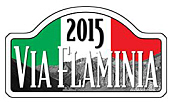
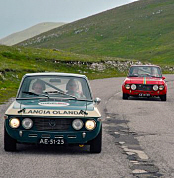
Climbing into the Alps
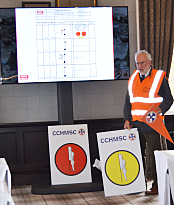
Maurice knows italian competition signs well, as here when he trained the Jaguar Mille Miglia crews in Scotland
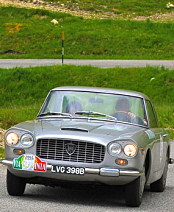
Lancia on the climb
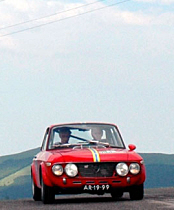
Lancia over the summit
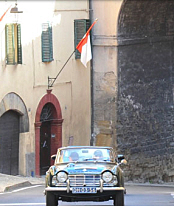
Triumph through streets of San Remo
| |
|  | From Mille Miglia to Via Flaminia 23 ot 30 May
Story - Maurice Millar. Photos Maurice Millar, David Mitchell, Jim Paterson Maurice joins Nan Beers in Triumph Dolomite 1850 HL
Having
struggled to get to Amsterdam in December 2009 for the first of the
winter solstice '100 Miles of Amsterdam' rallies, this overnight
vintage-only event was postponed at the last minute due to hard-frozen
snow and ice. However, I kept in touch with the organiser and, last
October, he contacted me to ask if I would like to navigate on one of
the 2015 Via Flaminia rally/tours: he had a driver looking for a
navigator.
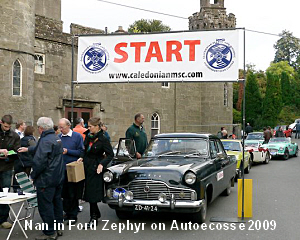 At
the time, there were no other foreign trips in the offing, so I agreed.
When I received a photo of the driver and his car, I immediately
recognised him from the Dutch 'Tour Ecosse' rallies in Scotland in 2008
and 2009. I sent him back a photo of me under the CCHMSC START banner
taken at the Swallow Hotel in Dundee in September 2008. I was the Start
timekeeper and he was sitting in his, then, black Ford Zephyr Mk2,
waiting for his due time. At
the time, there were no other foreign trips in the offing, so I agreed.
When I received a photo of the driver and his car, I immediately
recognised him from the Dutch 'Tour Ecosse' rallies in Scotland in 2008
and 2009. I sent him back a photo of me under the CCHMSC START banner
taken at the Swallow Hotel in Dundee in September 2008. I was the Start
timekeeper and he was sitting in his, then, black Ford Zephyr Mk2,
waiting for his due time.
Subsequently,
the Zephyr made way for a Volvo Amazon and now the current car for
rallies is a Triumph Dolomite 1850 (1973). It has been restored to
standard spec. The only rally preparation is a Brantz tripmeter; a pair
of wind-up stopwatches; and a couple of spotlights.
The Via
Flaminia Classic event started on Saturday 23 May from a vineyard near
Alessandria, about 90km SW of Milano, which just happened to have a
private collection of Lancia race and rally cars, all in Martini racing
livery.
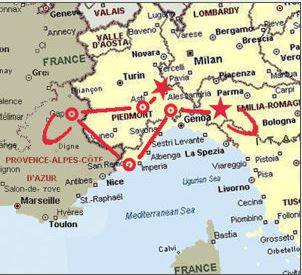 The
entry list of 26 cars includes various Alfas; a couple of Lancia
Fulvias; two matching Mercedes-Benz 280L; a fully rally prepared Ford
Mustang; two MGBs; and a replica Ferrari 500 Mondial. Most of these
cars and crews came from Holland, as the event is organised by a Dutch
organiser: one of four events he is arranging for 2015. The
entry list of 26 cars includes various Alfas; a couple of Lancia
Fulvias; two matching Mercedes-Benz 280L; a fully rally prepared Ford
Mustang; two MGBs; and a replica Ferrari 500 Mondial. Most of these
cars and crews came from Holland, as the event is organised by a Dutch
organiser: one of four events he is arranging for 2015.
The
format is similar to the Tulip Rally, with small-scale, out-of-date
maps provided. The route is defined by points and arrows on the
road-book maps. It is for the navigator to join these locations by the
shortest route. Via Flaminia events do not use codeboards. Each
morning, each crew is issued with an A4-page of matchbox-size
photographs of road-signs. Each photograph has a piece of information
blanked out. To prove that you have gone the correct route, you must
(a) find these signs, and (b) write down the missing information. There
are 30 penalties for each wrong sign. Some of these 'codeboards' are
false and collecting the missing information confirms that you took the
wrong route!
The rally route headed west via Barolo to Cuneo and
into France to the alpine village of Jausiers. The next days' routes
visited various high cols, including Col de la Bonette: the highest
road route in Europe, continuing to San Remo via Rallye Monte Carlo
territory, such as Col de Turini.
From San Remo, the route returned east through Liguria to Aqua Terme and on to the finish near Parma.
After
six and a half days, the Via Flaminia Classic 2015 is now over. Many
hundreds of kilometres and hundreds of hairpins have been driven. The
Dolomite has given no trouble at all. What did I learn? (a) that
spotting specific roadsigns and navigating is very difficult
(especially based on poor maps); (b) these events could be fun, but for
six days, sharing a car and accommodation, you need to be with a good
friend, if you are to enjoy the experience.
Full details of the via Flaminia can be found at
|
| Updated 1 June 2015
Webmaster
| |